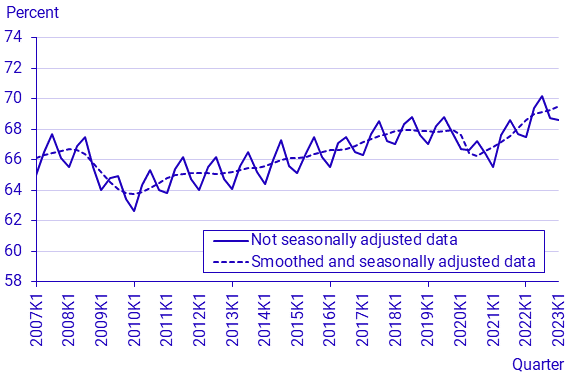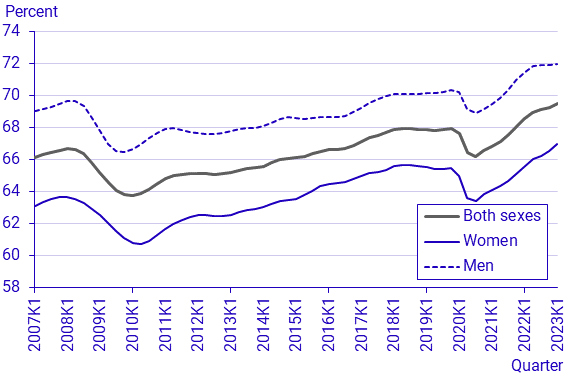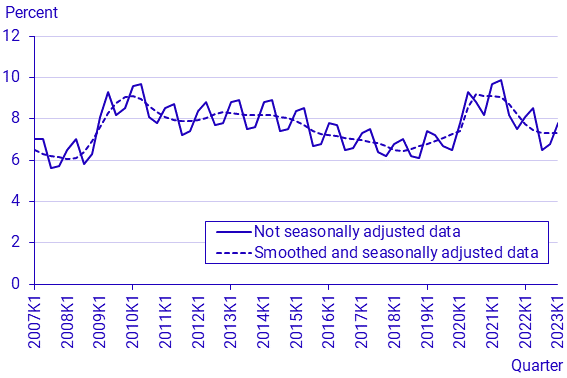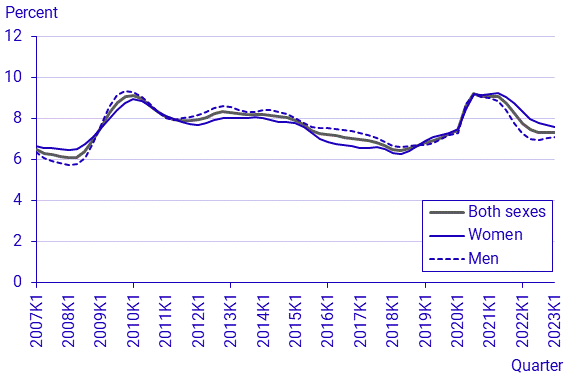Labour Force Survey (LFS), first quarter 2023
Employment is increasing among foreign born
Statistical news from Statistics Sweden 2023-05-11 8.00
In the first quarter of 2023, there were 5 187 000 employed persons, not seasonally adjusted. This is an increase of 111 000 persons compared to the first quarter of 2022. The average number of hours worked per week amounted to 167.3 million hours. In calendar-adjusted figures, this corresponds to an increase of 6.2 percent. There were 438 000 unemployed persons, corresponding to an unemployment rate of 7.8 percent. Seasonally adjusted and smoothed data indicates an increase in the number of employed. The seasonally and smoothed unemployment rate was 7.3 percent.
- For a long time, both the number and the share of employed foreign born have been increasing, which we also see in the first quarter of 2023. We further see a continued decrease in the share of unemployed foreign born, and especially among foreign born women. Altogether, this points to a positive development for foreign born, says Michella Szukis, statistician at the Labour Force Surveys at SCB.
The labour force
The number of persons in the labour force aged 15-74 years was 5 625 000 in the first quarter of 2023, not seasonally adjusted, an increase with 100 000. The number of women in the labour force amounted to 2 672 000, an increase with 66 000, and the number of men was 2 953 000, an increase with 34 000. The relative labour force participation rate increased by 0.9 percentage points to 74.4 percent. Among women it increased by 1.4 percentage points to 71.9 percent and among men it was 76.8 percent.
Seasonally adjusted and smoothed data shows an increase in the number and the share of persons in the labour force compared to adjacent quarters. There were 5 672 000 persons in the labour force, which corresponds to 75.0 percent of the population.
Employment
In the first quarter of 2023, there were 5 187 000 persons aged 15–74 in employment, not seasonally adjusted, which is an increase of 111 000 compared to the corresponding quarter a year ago. This corresponds to an employment rate of 68.6 percent, an increase of 1.1 percentage points. The number of employed women increased by 80 000 to 2 460 000 and the number of employed men amounted to 2 727 000 men. Among women, the employment rate increased by 1.8 percentage points to 66.2 percent and among men it was 70.9 percent. There were 487 000 young people aged 15–24 years in employment, an increase of 33 000. The employment rate for people aged 15-24 was 41.3 percent, an increase of 1.9 percentage points.
Seasonally adjusted and smoothed data indicates an increase in the number and share of employed persons compared to adjacent quarters. In the first quarter of 2023, there were 5 257 000 employed persons, which corresponds to an employment rate of 69.5 percent.
Employees
In the first quarter of 2023, there were 4 671 000 employees, not seasonally adjusted, which is an increase of 110 000 compared to the corresponding quarter of the previous year. Among those, 2 312 000 were women, an increase of 79 000, and 2 359 000 were men. There were 4 006 000 permanent employees, an increase of 101 000. Among permanent employees, the number of women increased by 76 000 to 1 947 000 and the number of men was 2 059 000. There were 666 000 temporary employees. Among them 366 000 were women and 300 000 men.
Compared to adjacent quarters, seasonally adjusted and smoothed data shows an increase in the number of employees and in permanent employees, and a decrease in temporary employees. According to seasonally adjusted and smoothed data, the number of employees was 4 742 000. The corresponding figure for permanent employees was 4 012 000 and for temporary employees 730 000.
Hours worked
The average number of hours worked per week in the first quarter of 2023 amounted to 167.3 million hours, not seasonally adjusted. In calendar-adjusted figures, this corresponds to an increase of 6.2 percent compared to the first quarter of 2022. Seasonally adjusted and smoothed data indicates an increase in the average number of hours worked per week compared to adjacent quarters. The number of hours worked averaged to 160.6 million per week.
The majority of employed persons have an agreed working time of 35 hours or more per week, that is, full-time work. In the first quarter of 2023, 4 065 000 persons worked full time. Among them 1 771 000 were women and 2 294 000 were men. In total, 261 000 persons worked short part-time (1–19 hours), and the number of persons who worked long part time (20-34 hours) amounted to 578 000 persons.1)
The average actual hours worked among employed persons aged 15–74 years increased by 0.9 hours and amounted to 32.2 hours per week in the first quarter of 2023. Women worked 29.9 hours per week, an increase by 0.6, and men worked 34.3 hours per week, an increase by 1.2.
1) Agreed working time in 2021 and 2022 excludes secondary jobs, this because the agreed working time in secondary jobs has not been collected since the implementation of the EU regulation 2019/1700. As of January 2023, the question regarding agreed working time in secondary jobs was reintroduced and total agreed hours worked are again reported in the Swedish LFS. However, comparisons with the corresponding quarter of the previous year are excluded during 2023.
Underemployment
Among employed persons aged 15–74, 325 000 were underemployed in the first quarter of 2023. This corresponds to an increase of 41 000 compared to the first quarter of 2022. The number of underemployed women increased by 19 000 to 153 000 and the number of men increased by 22 000 to 173 000. Underemployed persons accounted for 6.3 percent of employed persons.
Unemployment
In the first quarter of 2023, there were 438 000 unemployed persons aged 15–74, not seasonally adjusted. This corresponds to an unemployment rate of 7.8 percent. There were 212 000 unemployed women and 226 000 unemployed men. The unemployment rate for women was 7.9 percent and the male unemployment rate was 7.6 percent.
For persons aged 15–74, seasonally adjusted and smoothed data for the number of unemployed amounted to 415 000 in the first quarter, which corresponds to an unemployment rate of 7.3 percent.
There were 125 000 long-term unemployed persons (unemployed for at least 27 weeks) aged 15–74 years in the first quarter of 2023, a decrease of 31 000 compared to the first quarter of 2022. Among long-term unemployed persons, the number of women decreased by 20 000 to 54 000 and the number of men amounted to 71 000.
There were 152 000 unemployed young persons aged 15–24, not seasonally adjusted. This corresponds to an unemployment rate of 23.8 percent. Among young persons aged 15–24, seasonally adjusted and smoothed data shows an increase in the share of unemployed persons compared to adjacent quarters. The number of unemployed young persons amounted to 149 000, corresponding to an unemployment rate of 21.9 percent.
Not in the labour force
The group 'not in the labour force' includes persons who are not classified as employed nor as unemployed. In the first quarter of 2023, there were 1 938 000 persons not in the labour force, which is a decrease of 53 000 compared to the first quarter of 2022. The number of women not in the labour force decreased by 45 000 to 1 045 000 and the number of men was 893 000.
Among persons not in the labour force, retired persons decreased by 25 000 to 855 000, 644 000 were full-time students and 290 000 persons reported that they were on long-term sick leave, an increase by 28 000.
Latent job seekers
There were 245 000 latent job seekers aged 15–74 years in the first quarter of 2023, a decrease of 29 000 compared to the first quarter of 2022. Among young people aged 15–24, the number of latent job seekers decreased by 20 000 to 112 000.
Unused labour supply
Unemployed persons, underemployed persons and latent job seekers together comprise the unused labour supply. In the first quarter of 2023, the unused labour supply averaged 20.9 million hours per week. The unused labour supply corresponds to 523 000 full-time employments with 40-hour work weeks.
Labour market for persons aged 20-64 years
The population presented by the LFS is comprised of persons aged 15–74 years. However, labour market participation among younger and older in this age group is considerably lower for natural reasons, as this group contains large shares of students and retired persons. To better approach what can be seen as the core of the actively working population, the situation of the age group 20–64 years is described in the following section.
The relative labour force participation rate among persons aged 20–64 years amounted to 87.6 percent in the first quarter of 2023, not seasonally adjusted, which is an increase of 0.6 percentage points. For women, the relative workforce participation rate was 84.9 percent, and for men it was 90.1 percent. Seasonally adjusted and smoothed data shows an increase in the labour force participation rate which amounted to 88.0 percent.
In the first quarter of 2023, the share of employed persons aged 20–64 was 81.8 percent, not seasonally adjusted, an increase of 0.9 percentage points compared to the first quarter 2022. For women, the corresponding figure was 79.3, an increase of 1.5 percentage points, and for men it was 84.2 percent. Seasonally adjusted and smoothed data shows an increase in the employment rate which was 82.7 percent.
According to not seasonally adjusted data, the unemployment rate in the age group 20–64 amounted to 6.6 percent in the first quarter of 2023. The unemployment rate among women decreased with 1.0 percentage points to 6.6 percent and for men it was 6.5 percent. According to seasonally adjusted and smoothed data the unemployment rate was 6.1 percent.
Swedish born and foreign born persons aged 20–64 years
The relative labour force participation rate among Swedish born persons aged 20–64 years was 87.9 percent in the first quarter of 2023, not seasonally adjusted. Among Swedish born women, the relative participation rate amounted to 86.1 percent, and among Swedish born men it was 89.5 percent. Among foreign born persons aged 20–64 years, the relative participation rate was 86.7 percent, an increase of 2.5 percentage points compared to the corresponding quarter in 2022. The corresponding figure was 81.7 percent among foreign born women, and 91.7 percent among foreign born men, an increase with 2.7 and 2.4 percentage points, respectively. Compared to adjacent quarters, seasonally adjusted and smoothed data shows an increase in the labour force participation rate among foreign born persons. The labour force participation rate amounted to 88.5 percent among Swedish born persons and 86.7 percent among foreign born persons.
In the first quarter of 2023, the share of employed Swedish born persons aged 20–64 was 84.6 percent, not seasonally adjusted. Among Swedish born women, the employment rate was 83.0 percent and among Swedish born men the employment rate was 86.0 percent. Among foreign born persons, the employment rate was 74.2 percent, an increase of 3.7 percentage points. The employment rate among foreign born women was 69.4 percent, an increase of 5.1 percentage points. Among foreign born men it increased by 2.5 percentage points to 79.1 percent. Seasonally adjusted and smoothed data shows an increase in the employment rate compared to adjacent quarters for foreign born persons. The employment rate was 85.5 percent among Swedish born and 74.7 percent among foreign born persons.
The relative unemployment rate among Swedish born persons aged 20–64 years was 3.8 percent in the first quarter of 2023, not seasonally adjusted. Among Swedish born women, the unemployment rate was 3.6 percent, and the male unemployment rate was 4.0 percent. The unemployment rate among foreign born persons decreased by 1.9 percentage points to 14.4 percent. Among foreign born women it was 15.1 percent, a decrease of 3.6 percentage points, and among foreign born men the corresponding number was 13.7 percent. According to seasonally adjusted and smoothed data, the unemployment rate for Swedish born increased compared to adjacent quarters and amounted to 3.4 percent. Among foreign born, the seasonally adjusted and smoothed unemployment rate decreased compared to adjacent quarters and was 13.8 percent.”




Definitions and explanations
Since the LFS is a sample survey, the results are subject to some uncertainty. The LFS basic tables contain uncertainty figures and refer to non-seasonally adjusted data.
Seasonally adjusted and smoothed data (trend values): data in which normal seasonal variations have been removed, then smoothed to reduce sampling error and short-term variations. Seasonally adjusted and smoothed data may be revised following new monthly outcomes and usually does not coincide with non-seasonally adjusted data. Seasonally adjusted and smoothed data is not to be compared with non-seasonally adjusted data.
More detailed results are available in the form of figures and tables on employed persons, hours worked, unemployed persons and more, on Statistics Sweden’s website.
Next publishing will be
2023-05-25, at 08:00.
Feel free to use the facts from this statistical news but remember to state Source: Statistics Sweden.
